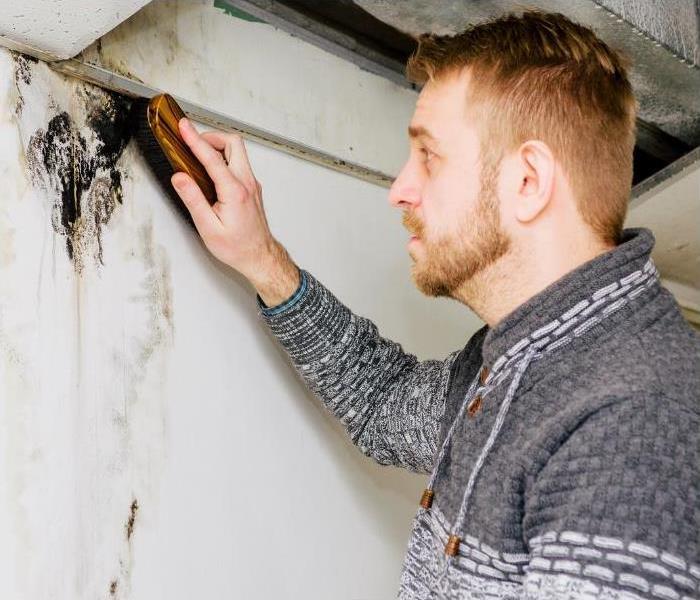How to Identify a Mold Problem in Your Colorado Springs Home
3/7/2024 (Permalink)
Nestled at the foot of the majestic Rocky Mountains, Colorado Springs is renowned for its stunning landscapes and outdoor adventures. However, beneath the scenic beauty lies a potential threat that can quietly invade your home – mold. Mold growth is a common issue in many households, and Colorado Springs is no exception. The semi-arid climate, occasional heavy rains, and fluctuating temperatures create an environment conducive to mold development. In this blog, we'll explore the signs of a mold problem in your Colorado Springs home and discuss the importance of timely identification and remediation.
Understanding the Colorado Springs Climate
Colorado Springs experiences a unique climate that can contribute to mold growth. With low humidity levels and significant temperature variations, especially between day and night, the conditions are ripe for mold to flourish. The occasional heavy rains during the summer months can also elevate moisture levels, creating an ideal breeding ground for mold spores.
Identifying Common Mold Species
Mold comes in various shapes and forms, with some species posing potential health risks. In Colorado Springs, you may encounter molds like Stachybotrys chartarum (black mold), Aspergillus, Cladosporium, and Penicillium. Each mold species has distinct characteristics, colors, and potential health effects. Recognizing these differences can be crucial in identifying a mold problem in your home.
Visible Signs of Mold
One of the most apparent indicators of a mold issue is visible mold growth. Mold can appear as fuzzy patches, discoloration, or even black spots on walls, ceilings, and other surfaces. Pay close attention to damp or humid areas such as bathrooms, basements, and kitchens, as these are common hotspots for mold growth. If you notice any unusual spots or discoloration, it's essential to investigate further to determine if mold is the culprit.
Musty Odors
Mold often produces a distinct musty odor that can permeate your living spaces. If you catch a whiff of an unpleasant, earthy smell, it could be a sign of hidden mold growth. Pay attention to areas with poor ventilation or high humidity levels, as these are prime locations for mold to thrive. Investigate the source of the odor to identify and address any potential mold problems.
Allergic Reactions
Mold spores can trigger allergic reactions in sensitive individuals. If you or your family members experience unexplained allergic symptoms such as sneezing, coughing, itchy eyes, or respiratory issues, it might be indicative of a mold problem in your home. Consider consulting with a healthcare professional to rule out other causes and take steps to investigate and address any potential mold sources.
Water Leaks and Moisture Issues
Colorado Springs residents are no strangers to occasional heavy rains and snow. These weather events can lead to water leaks, which, if left unattended, create favorable conditions for mold growth. Inspect your home for signs of water damage, such as stained ceilings, peeling paint, or warped walls. Addressing water leaks promptly is crucial in preventing mold proliferation.
Humidity Levels
Low humidity levels are a defining characteristic of Colorado Springs' climate. However, there are instances, especially during the summer months, when humidity levels can rise. Keep an eye on indoor humidity using a hygrometer, aiming to maintain levels between 30-50%. Excessive humidity can create a hospitable environment for mold, making it essential to implement proper ventilation and moisture control measures.
Condensation on Windows
Condensation on windows is a common occurrence in homes, especially during the colder months. However, persistent condensation can indicate elevated humidity levels and poor ventilation, potentially leading to mold issues. Regularly inspect and wipe down windows to prevent moisture buildup and consider implementing measures such as improved ventilation and dehumidification to mitigate mold risks.
Hidden Mold in HVAC Systems
The HVAC (Heating, Ventilation, and Air Conditioning) system in your home plays a crucial role in regulating indoor air quality. Unfortunately, HVAC systems can also harbor hidden mold if not properly maintained. Inspect your HVAC system for signs of mold growth, such as foul odors or visible mold in ducts and vents. Regular professional maintenance can help prevent and address mold issues in your home's ventilation system.
DIY Mold Testing Kits
If you suspect a mold problem but can't identify the source, DIY mold testing kits are available. These kits typically include sampling materials and instructions for collecting mold samples from your home. Keep in mind that while these kits can provide initial insights, they may not be as accurate as professional mold testing conducted by certified inspectors. If the DIY test indicates the presence of mold, it's advisable to consult with professionals for a comprehensive assessment.
Professional Mold Inspection
For a thorough and accurate assessment of mold in your Colorado Springs home, consider hiring a certified mold inspector. These professionals have the expertise and equipment to identify hidden mold, assess the extent of the problem, and provide recommendations for remediation. A professional inspection is particularly crucial if you suspect extensive mold growth or if there are underlying structural issues contributing to the problem.
Identifying a mold problem in your Colorado Springs home requires vigilance, especially in a climate prone to temperature fluctuations and occasional heavy rains. By staying alert to visible signs, monitoring indoor humidity, addressing water leaks promptly, and conducting periodic inspections, you can safeguard your home and family from the potential health risks associated with mold. If you suspect a mold issue, don't hesitate to seek professional assistance for a comprehensive assessment and effective remediation. With proactive measures, you can enjoy the breathtaking beauty of Colorado Springs without the silent threat of mold lurking within your home.




 24/7 Emergency Service
24/7 Emergency Service
